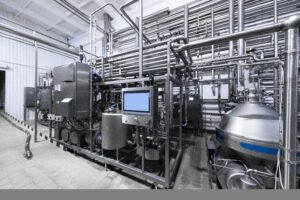The success of any company is intricately tied to numerous factors, and among these, the choice of industrial location stands out as a pivotal determinant. The decision of where to establish manufacturing facilities has far-reaching implications, influencing operational efficiency, cost structures, access to resources, and market reach. This comprehensive article delves into the multifaceted role that industrial location plays in the success of companies, exploring key aspects such as cost considerations, proximity to resources, workforce dynamics, and strategic positioning within the global market.
Operational Efficiency and Cost Considerations:
At the heart of industrial location strategy lies the pursuit of operational efficiency and cost-effectiveness. The proximity of manufacturing facilities to suppliers, distribution networks, and key transportation hubs significantly impacts the efficiency of production processes. Companies strategically choose locations that minimize transportation costs, reduce lead times, and optimize supply chain operations.
Additionally, the cost of labor, land, and utilities varies across regions, influencing the overall cost structure of a company. For example, establishing manufacturing plants in regions with lower labor costs can lead to substantial savings. Similarly, selecting locations with favorable tax environments and incentives can contribute to enhanced financial viability.
Through meticulous analysis of these operational and cost considerations, companies can make informed decisions regarding industrial location, gaining a competitive edge by streamlining their production processes and improving the bottom line.
Proximity to Resources and Raw Materials:
The accessibility and availability of resources and raw materials play a crucial role in the success of manufacturing companies. Strategic industrial location ensures proximity to key inputs, reducing transportation costs and minimizing the risks associated with supply chain disruptions. Companies often establish facilities near raw material sources or in regions rich in the resources necessary for their production processes.
This proximity not only aids in cost reduction but also enables companies to have better control over the quality and consistency of inputs. By securing a reliable and efficient supply chain for raw materials, companies can enhance their production stability, reduce lead times, and respond more effectively to market demands.
Moreover, being close to resources facilitates sustainable practices, allowing companies to minimize their environmental footprint by reducing the energy required for transportation and fostering local partnerships with suppliers.
Workforce Dynamics and Skill Availability:
The availability of a skilled and motivated workforce is a critical factor influencing the success of manufacturing companies. Industrial location decisions are often shaped by the presence of an educated and skilled labor pool. Companies strategically position their facilities in regions with access to a workforce with the necessary technical expertise and industry-specific skills.
Furthermore, proximity to educational institutions and training centers ensures a continuous supply of qualified workers. Establishing operations in locations with a strong educational infrastructure fosters a collaborative ecosystem where companies can engage with academia to enhance workforce skills and drive innovation.
The dynamics of the labor market, including wage levels, labor laws, and cultural factors, also impact industrial location decisions. By aligning their facilities with workforce dynamics, companies can create a conducive environment for employee satisfaction, productivity, and long-term success.
Strategic Positioning in the Global Market:
In an interconnected global economy, the strategic positioning of manufacturing facilities is paramount for companies aspiring to compete on a global scale. Industrial location influences a company’s ability to access diverse markets, respond to regional preferences, and navigate geopolitical considerations.
Companies often adopt a decentralized approach, establishing facilities in key regions to cater to local markets efficiently. This approach minimizes transportation costs and allows companies to adapt products to meet specific regional requirements.
Moreover, industrial location is closely tied to trade policies and international relations. By strategically positioning facilities in regions with favorable trade agreements and geopolitical stability, companies can mitigate risks associated with global uncertainties and access a broader customer base.
The strategic importance of industrial location extends beyond proximity to markets—it also involves understanding and adapting to the regulatory environments of different regions. Successful companies navigate these complexities by aligning their operations with global market trends and leveraging their industrial locations to gain a competitive advantage.
Infrastructure and Technological Advancements:
The availability of robust infrastructure and access to technological advancements are pivotal considerations in industrial location decisions. Proximity to transportation networks, ports, and communication hubs streamlines logistics and ensures timely delivery of products to customers. Companies strategically choose locations with well-developed infrastructure to minimize operational bottlenecks and enhance overall efficiency.
Additionally, industrial clusters that bring together multiple companies within the same industry contribute to a collaborative environment. These clusters often result in shared infrastructure, knowledge exchange, and synergies that benefit all participants. By selecting locations with established industrial ecosystems, companies can tap into collective expertise, reduce costs through shared resources, and stay at the forefront of technological innovations.
The integration of Industry 4.0 technologies, such as automation, artificial intelligence, and data analytics, further accentuates the importance of industrial location. Companies that position their facilities in regions where these technologies are embraced gain a competitive edge in terms of operational efficiency, product quality, and innovation.
Conclusion:
In conclusion, the strategic significance of industrial location cannot be overstated in the success of any company. From operational efficiency and cost considerations to proximity to resources, workforce dynamics, global market positioning, and infrastructure, the decision of where to establish manufacturing facilities reverberates across all aspects of a company’s operations.
Companies that meticulously analyze these factors and align their industrial location strategy with their overall business objectives stand to gain a competitive advantage. In an ever-evolving global landscape, the ability to adapt and strategically position manufacturing facilities contributes not only to short-term operational efficiency but also to long-term sustainability and success.
Ultimately, industrial location is a dynamic and multifaceted decision that requires careful consideration of both internal and external factors. By recognizing the pivotal role of industrial location and making informed decisions, companies can navigate the complexities of the business landscape, optimize their operations, and position themselves for sustained success in an increasingly competitive global marketplace.












